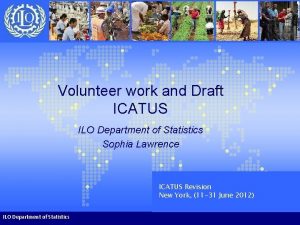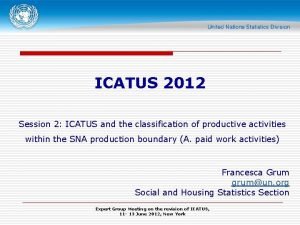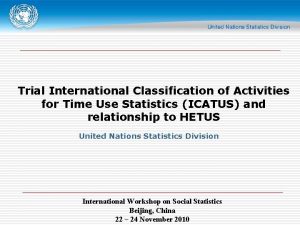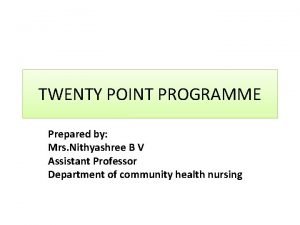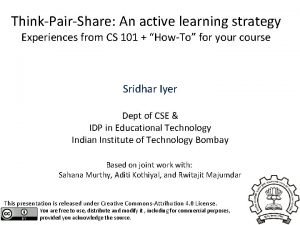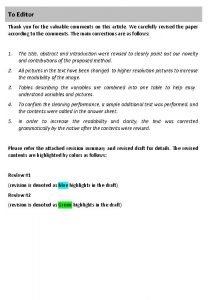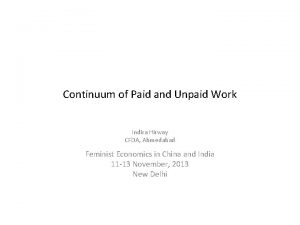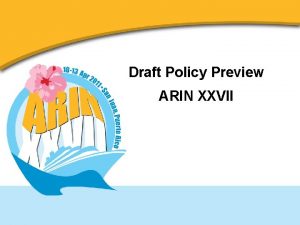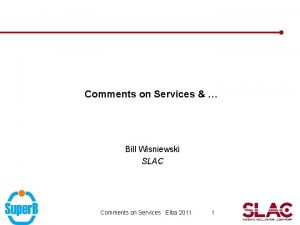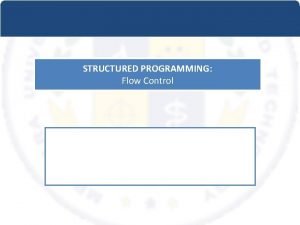COMMENTS ON DRAFT ICATUS 2012 Indira Hirway Centre












![Major Divisions of Time Use Activities under Different Classification Pre-1997[1] UNSD- 1997 UNSD 2005 Major Divisions of Time Use Activities under Different Classification Pre-1997[1] UNSD- 1997 UNSD 2005](https://slidetodoc.com/presentation_image_h2/0be4a58d989ec60498feb20b6df1b745/image-13.jpg)











- Slides: 24

COMMENTS ON DRAFT ICATUS 2012 Indira Hirway Centre For Development Alternatives, India EGM at UNSD, New York June 2012.

Objectives of TUS determine TUS Activity Classification • Evolution in the objectives of TUS – economic objectives are increasingly getting important • Entry of developing countries has shifted the focus towards economic objectives • In the global economy today – particularly in the background of the global crisis, TUS has an important role to play • There is a need to have SNA framework

Conceptual Framework for TUS Activity Classification - 1 • Necessary Time: the activities that are necessary for human beings, related to basic physiological needs of people, such as, eating, sleeping, health and hygiene • Contracted Time: the activities that people have been contracted to perform, such as work/employment or study. • Committed Time: Activities which are committed by people to maintain a house or family, such as, house work, care of children, shopping for family, or activities performed for non-household members or voluntary organizations. • Free Time: The time left after the three above activities are performed. These activities include leisure activities, socialization etc.

Time Use Activity Classifications in Selected Developed Countries Australia HETUS Eurostat Canada ISAC * 1. Personal care 0. Personal care 5. Personal care 1. Personal Needs 2. Employment Related Activities 1. Employment 1. Employed work 2. Paid Work 3. Education Activity 2. Study 6. School and education 3. Study 4. Domestic Activities 3. Household and family care 2. Domestic work 4. Household and family care 5. Child care activities 3. Care of children 6. Purchasing goods and services 4. Shopping and services 7. Voluntary work and related care activities 4. Voluntory work &meetings 7. Organisational and Voluntary &religious activities 5. Voluntary work and community participation 8. Social & community Interaction 5. Social life and entertainments 8. Entertainment 6. Socializing 9. Recreation and leisure 6. Sports and Outdoor activities 7. Hobbies & games 7. Sports participation 9. Sports & Hobbies (participation) 8. Hobbies and craft (participation) 9. Entertainment and culture (attendance) 8. Mass Media 10. Media and 10. Mass Media 9. Travel and unspecified time Note: * International Standard Activity Classification developed by Harvey A & Niemi Iiris (1996) Source: Country Reports on Time Use Surveys

Classification of Economic Work in the Classifications of Industrialized Countries Australia HETUS Eurostat Canada USA 2003 -4 1. Main Job 1. Main job 1. Work for pay at main job 1. work for pay 2. Other Job 2. Second job 2. Work for pay at other jobs 2. work related activities 3. other income generating activities 3. Overtime work 3. Unpaid work in family business/firm 5. Unpaid work in family Business/firm 4. Work breaks 5. Job search 4. Looking for work 6. Associated communication 3. Activities related to employment ( job seeking, lunch breaks, etc. ) 5. Government service 7. Associated travel 8. Employment related activities 6. Travel during work 7. Waiting / delays in work 8. Meals / snacks at work 8. Idle time 9. Coffee/other breaks 10. Other work activity 11. Travel from to work Source: Country Reports on Time Use Surveys. 4. job search & interviewing

Conceptual Framework for TUS Activity Classification – 2 UNSD • UN SNA activities falling within the production boundary • Extended SNA activities falling outside the production boundary but within the General production Boundary • Personal, activities – non-delegable activities

UNSD’s Trial Time Use Activity Classification (1997) (3 -digit) Main Groups Subgroups 1. Employment for establishments 7 2. Primary production activities not for establishments 8 3. Services for income and other production of goods not for establishments 9 4. Household maintenance, management and shopping for own household 9 5. Care for children, the sick, elderly and disabled for own household 8 6. Community services and help to other households 9 7. Learning 6 8. Social, cultural and recreational activities 9 9. Mass media use 7 0. Personal care and self-maintenance 8 Activities In 3 -digits

Problems with UNSD 1997 Classification • The first group is expected to capture formal SNA work and 2 -3 groups are expected to capture informal non-SNA work - the three groups however are not really capable of distinguishing formal and informal work. • This classification could not identify industry groups of additional workers netted through TUS • Since most of the activities performed in the first group are also performed in the second or the third groups, there is considerable repetition of activities in the first and the other groups lengthening the list of activities and confusing the investigators and coders.

Structure of ICATUS 2000 Categories Divisions A. Work for corporations/quasi-corporations, non profit institutions and government (formal sector work) B Work for household enterprises in primary production activities C. Work for household enterprises in non-primary production activities D. Work for household enterprises in construction activities E. Work for household enterprises providing services for income F. Providing unpaid domestic for own final use within household G. Providing unpaid care giving services to household members H. Providing community services and help to other households I. Learning J. Socializing and community participation K. Attending/visiting cultural, entertainment and sports events/venues L. Hobbies, games and other pastime activities M. Indoor and outdoor sports participation and related courses N. Mass media O. Personal care and maintenance Source: UNSD, New York, 2000 C

ICATUS Major Divisions within the SNA typological matrix Productive Activities Non- Productive (personal) Within SNA Productive Boundary Outside SNA productive Boundary 01 Formal employment 06 Household – services for own use 09 Learning 02 Household – primary production of goods 07 Household- unpaid care 10 Socializing 03 Household – non-primary production of goods 08 Household – volunteer work 11 Cultural, entertainment 04 Household-construction 12 Hobbies, games 05 Household- services for income 13 Sports 14 Mass media 15 Personal care

Problems with ICATUS 2000 • Division 01 is treated as formal sector and 2 -5 as informal – however this is not valid • Since it is likely that TUS nets additional workers in the institutions included in Division 1 – however there is no way we know their industry classes • Putting “looking for work” in each major division is not required • The classification is lengthy, clumsy and complex

ICATUS 2012 • • • 1 Paid work 2 Unpaid domestic services for own final use within household 3 Unpaid care-giving services to household members 4 Community services and help to other households 5 Learning 6 Socializing and community participation 7 Leisure and sports 8 Personal care and maintenance Results from the merge of major divisions 11, 12, 13 and 14 of ICATUS 2005
![Major Divisions of Time Use Activities under Different Classification Pre19971 UNSD 1997 UNSD 2005 Major Divisions of Time Use Activities under Different Classification Pre-1997[1] UNSD- 1997 UNSD 2005](https://slidetodoc.com/presentation_image_h2/0be4a58d989ec60498feb20b6df1b745/image-13.jpg)
Major Divisions of Time Use Activities under Different Classification Pre-1997[1] UNSD- 1997 UNSD 2005 UNSD 2012 SNA activities 1 3 5 1 Non-SNA 3 -4 3 3 3 Personal activities 4 -5 4 7 4 Total 9 10 15 8 [1] This classification is used mainly by developed countries

SNA Needs more Major Divisions • About two third of countries in the South want TUS for improving estimates and understanding of informal / subsistence work • TUS data are useful for the countries in the North also for “economic” reasons – economic objectives are getting increasingly important at the global level • Under an SNA framework, one needs equal weitage to SNA activities • The percent share of the time spent on SNA activities is significant

Estimated WPR from NSSO and TUS (with comparable concepts of “work”) NSSO 1999 -00 TUS 1998 -99 Rural Urban Male Female Person Haryana 46. 2 17. 7 32. 8 Madhya Pradesh 51. 2 30. 7 Gujarat 57. 1 Orissa Male Femal e Perso n Female Person 58. 7 61. 47 59. 9 50. 2 10. 0 31. 3 54. 5 39. 08 47. 6 41. 3 61. 8 54. 92 58. 6 47. 3 12. 1 30. 5 57. 5 30. 68 44. 9 35. 5 46. 4 63. 4 58. 48 61. 1 52. 9 12. 5 33. 6 56. 9 25. 78 42. 3 52. 7 23. 3 37. 9 61. 7 58. 34 60. 0 45. 7 11. 6 29. 3 58. 4 30. 97 45. 8 Tamil Nadu 56. 6 38. 1 47. 4 68. 4 60. 62 64. 5 55. 2 20. 1 38. 1 63. 8 34. 21 48. 9 Meghalay a 55. 6 42. 0 48. 7 58. 6 59. 35 58. 9 39. 3 19. 7 29. 7 53. 8 35. 06 43. 8 Combined States 51. 0 25. 3 38. 4 63. 3 58. 2 60. 8 50. 9 12. 8 32. 7 59. 3 30. 89 45. 67 States Male Female Person

NSSO and TUS Based WPRs by Age Groups: Male Source: Hirway and Jose 2011, based on TUS 1998 -99 and NSSO 1999 -00

NSSO and TUS Based WPRs by Age Groups: Female Source: Hirway and Jose 2011, based on TUS 1998 -99 and NSSO 1999 -00

NSSO and TUS Based WPRs by Age Groups: Male + Female Source: Hirway and Jose 2011, based on TUS 1998 -99 and NSSO 1999 -00

ICATUS Groups within Division 1: • 11 Work for corporations/quasi corporations, non-profit institutions and government (“formal sector” work) • 12 Work for household in primary production activities • 13 Work for household in non-primary production activities • 14 Work for household in construction activities • 15 Work for household providing services for income • 16 Looking for work / setting up business • 18 Travel related to paid work • 1 x Other activities related to paid work not elsewhere classified (n. e. c)

Problems with the SNA groups in ICATUS 2012 • Division 01 cannot be treated as formal sector and employment in this division • time use surveys are likely to net additional workforce from the formal as well as informal sector units. And if this is the case, it will be important to collect information on the “industry” class of the workers of the formal sectors also – so that new estimates of workforce will be available industry-wise.

Reorganization of SNA Activities • Activities in the production in the primary sector, • Activities in the production in the secondary sector and • Activities in the tertiary sector – in trade and services. • Each of these divisions can be classified and sub-classified into detailed sectors and sub-sectors and activities: • • 1 division (work for primary production activities 11 Growing crops and trees; kitchen gardening 111 onwards 1111 further details

Use of Context Variables • For whom • With Whom • Location • Others: paid / unpaid; use of technology etc

Advantages of this Classification • It takes into account - is comparable with all the major classification schemes in developed and developing countries • It serves the major objective of the TUS in the South - it helps in identifying industry classification of additional employment netted • It serves the major objective of the TUS in the North • It is simple and easy to operate • With the right kind of context variables, the classification is enriched in terms of its interpretation and utility.

THANK YOU!
 Objective of draw frame
Objective of draw frame Icatus
Icatus Icatus
Icatus Icatus
Icatus 20 point programme ppt
20 point programme ppt Inheretance
Inheretance Citate din maitreyi
Citate din maitreyi Srimati devi indira
Srimati devi indira Tarea
Tarea Weight center
Weight center Gravity center
Gravity center Thinkpairshare
Thinkpairshare Tat meaning in hr
Tat meaning in hr Reviewer comments
Reviewer comments What went well comments
What went well comments C++ style comments
C++ style comments Comments for chapter 13
Comments for chapter 13 Thank you for valuable comments
Thank you for valuable comments Aja cortizo
Aja cortizo Commentswrite a comment…
Commentswrite a comment… What woke katniss up the first night?
What woke katniss up the first night? Pyp exhibition comments
Pyp exhibition comments Honest appraisal
Honest appraisal Comments and suggestions for teachers observation
Comments and suggestions for teachers observation Pydoc comments
Pydoc comments

